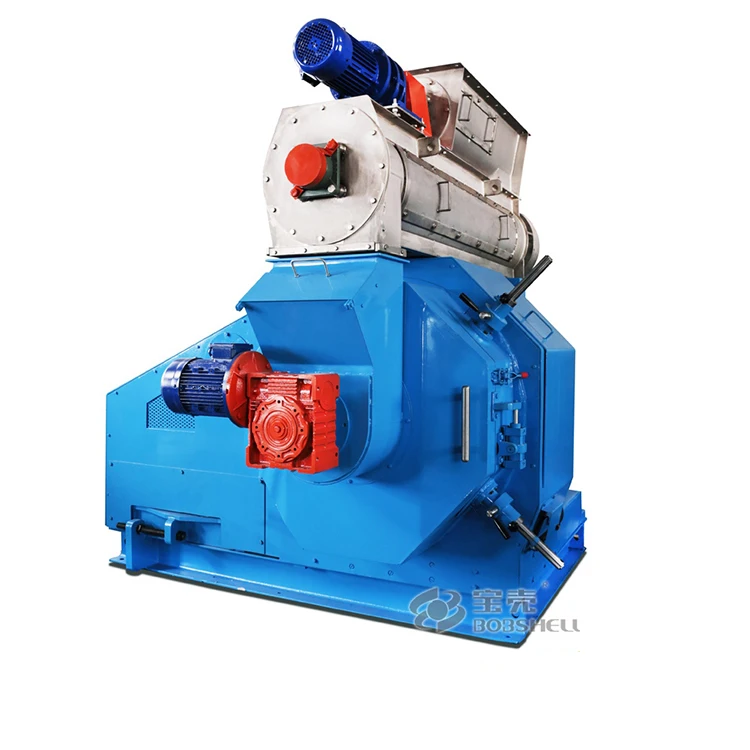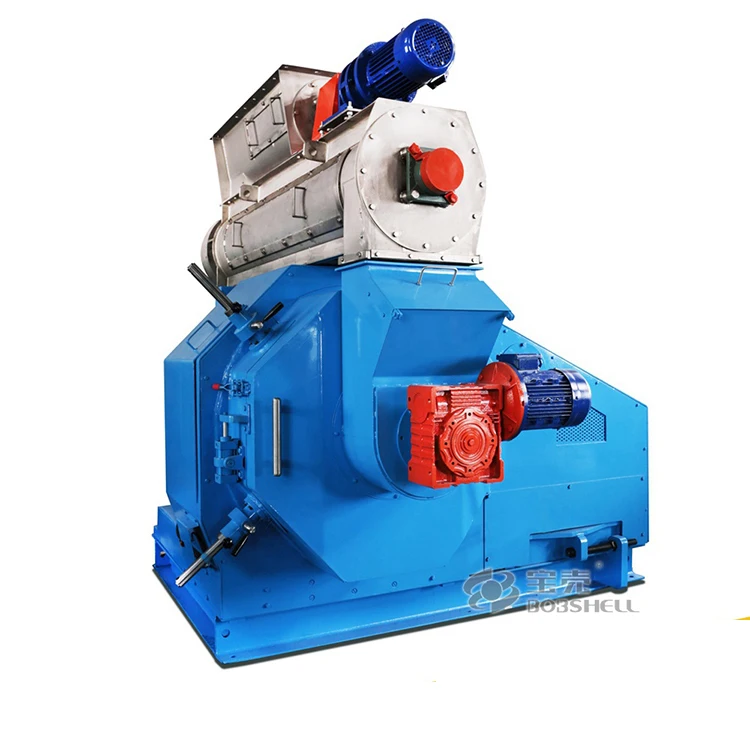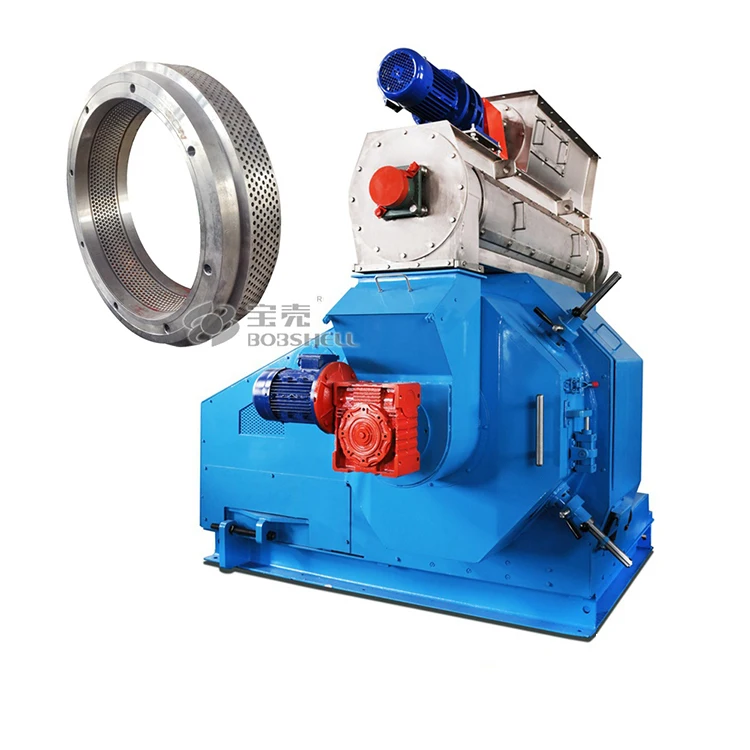Producing wood pellets,animal feeds pellets and other pellets
MOQ: 1 pcs
Delivery time:10 to 30 days after receipt of the advance payment
The entire machine is guaranteed fo r 3 years, except fo r easily worn parts.
Ring die: Working life of bloenergy pellets be 1000 hours, Working life of animal feed pellets be 1500 hours.
All steel from top tier factories will be used
Compliant with GB/T 19001-2016/ISO 9001:2015
The factory covers an area of over 13000 square meters and has two large production workshops and a comprehensive warehouse.
The company specializing in the production of biomass pellet equipment unit (chicken feed pellet mill,self contained pellet mill,large wood pellet mill,leaf pellet mill,flat die pellet mill,feed pellet mill machine, etc.). Company since its establishment to obtain rapid development, its core superiority performance is as follows: one, the cost advantage: external long-term, direct cooperation with suppliers, reduce the intermediate links, internal lean production mode can be taken to reduce the manufacturing cost; Second, the advantage of technology innovation: technology innovation incentive mechanism to increase the power, speed up the pace of innovation, improve the efficiency of innovation; Third, perfect management method, the communication between government departments, work together, reflect the rapid directly.Company long-term adherence to the \perfect ourselves
| Product name | food pellet mill |
| Keyword | chicken feed pellet mill,self contained pellet mill,large wood pellet mill,leaf pellet mill,flat die pellet mill,feed pellet mill machine |
| Place of Origin | China |
| Production Capacity | 1039~400/Per Min |
| Power | 2.2~6kw |
| Thread Dia(mm) | 2.0~4.0 |
| Thread Length(mm) | 4~50 |
| Feature | pipe nipple threading machine in its rolling pressure range of cold, the workpiece for thread, ruled, twill and other treatment; straight, helical and oblique spline gear rolling; straightening, reducing diameter, rolling and various forming rolling. |
| Dimensions | 3233mm*2362mm*2333mm, (Contact us for specific information to confirm) |
| Applicable Industries | livestock farms, etc. |
| Color | Ash or customized |
| Weight | 5266kg |
| Product Description | The machine has a safe and reliable electro-hydraulic execution and control system. Each work cycle can be selected in manual, semi-automatic and automatic ways. |
| terms of packing | enerally, we pack our goods in plywood cases. |
| terms of paymen | T/T 30% as deposit, and 70% balance against BL copy |
| Life span | 11 years (Contact us for specific information to confirm) |
| After-sale service | 12 months warrantly, man-made destory will be exception. |
| food pellet mill Advantage | We keep good quality and competitive price to ensure our customers benefit |
| Packing | 3975x2564x3199mm(Contact us for specific information to confirm) |
| OEM/ODM | Customization Service Provided |
| Sales country | All over the world for example:Brunei,Germany,New Caledonia,Cook Islands,Burkina Faso |
| MOQ | 3pcs(Contact us for specific information to confirm) |
| Delivery time | 15-20 days for OEM, 5-7days for ready goods. |



food pellet mill
as one of the most professional food pellet mill manufacturer has the advantages at:
The company's BOBSHELL brand serial products have accumulated served over 1200 clients around the world and be long-lasting reliable supplier of GF, LA MECCANICA, CPM, BUHLER, ANDRITZ which are world famous firms in Pellet industry.
Hongxing Machinery insists on the mission of "World class quality,serve Chinese clients to expand the markets."Bobshell" parts have gained huge competition advantages in the fields of animal feeds,biomass fuels,chemicals, organic fertilizers etc.
food pellet mill services FAQs Guide
Are you looking for a quick review guide about food pellet millservices?
An ultimate FAQ buying guide is available to help you.This guide contains all the information about all the important facts, figures, and various processes regarding food pellet mill services.
Let’s continue!
1.What is the potential for food pellet mills in developing countries?
We have established a good reputation and reliable partnerships within the food pellet mill industry.
Pellet mills have a significant potential in developing countries due to their ability to produce high-quality, affordable and sustainable fuel sources. These countries often have limited access to traditional sources of energy such as electricity and fossil fuels, making them heavily reliant on biomass for cooking and heating. Pellet mills can efficiently convert agricultural waste, sawdust, and other biomass materials into compact and uniform pellets that can be used as a clean and renewable energy source. This can greatly reduce the reliance on traditional fuels and improve the overall energy security and sustainability of these countries. Additionally, pellet mills can also create job opportunities and stimulate economic growth in rural areas where biomass resources are abundant. With proper investment and support, pellet mills have the potential to play a crucial role in promoting sustainable development and reducing poverty in developing countries.
2.How can a food pellet mill be incorporated into existing agricultural systems?
We have the leading technology and innovation capabilities, and attach importance to employee training and development, and provide promotion opportunities.
A pellet mill can be incorporated into existing agricultural systems in several ways:
1. Utilizing crop residues: Agricultural systems produce a large amount of crop residues such as straw, corn stalks, and rice husks. These residues can be used as raw materials for pellet production, reducing waste and providing an additional source of income for farmers.
2. Diversifying feed sources: Pellets can be used as a feed source for livestock, providing a balanced and nutritious diet. This can help reduce the reliance on traditional feed sources and improve animal health and productivity.
3. Adding value to by-products: By-products from agricultural processes, such as sawdust from lumber mills or manure from livestock operations, can be turned into pellets and sold as a valuable product.
4. Generating renewable energy: Pellets can be used as a source of renewable energy, either for on-farm use or for sale to the grid. This can help reduce the carbon footprint of agricultural operations and provide an additional source of income.
Overall, incorporating a pellet mill into existing agricultural systems can help increase efficiency, reduce waste, and provide additional sources of income for farmers.

3.What are the key components of a high-quality food pellet mill?
We continue to improve food pellet mill products and processes to improve efficiency.
1. Robust frame and structure: A high-quality pellet mill should have a strong and durable frame and structure to withstand the high pressure and force during the pelletizing process.
2. Efficient motor: The motor is the heart of a pellet mill and should be powerful enough to handle the workload and maintain a consistent speed.
3. Die and rollers: The die and rollers are crucial components that shape the pellets and determine their quality. They should be made of high-quality materials and have a precise design to ensure consistent and uniform pellets.
4. Feeder and conditioner: The feeder and conditioner are responsible for regulating the flow of raw materials and adding moisture to the mixture, respectively. They should be designed to work efficiently and evenly distribute the materials.
5. Control system: A high-quality pellet mill should have a reliable control system that allows for precise adjustments and monitoring of the pelletizing process.
6. Cooling system: A cooling system is essential to prevent the pellets from overheating and maintain their quality. It should be designed to cool the pellets quickly and evenly.
4.What are the safety considerations when operating a food pellet mill?
We have established long-term and stable partnerships with our suppliers, so we have great advantages in price and cost and quality assurance.
1. Proper Training: It is important to receive proper training on how to operate a pellet mill before using it. This will ensure that you know how to use the machine safely and effectively.
2. Wear Protective Gear: When operating a pellet mill, it is important to wear appropriate protective gear such as safety glasses, gloves, and earplugs. This will protect you from any potential hazards or accidents.
3. Keep Hands and Clothing Clear: Make sure to keep your hands and clothing clear of the pellet mill while it is in operation. Loose clothing or jewelry can get caught in the machine and cause injury.
4. Regular Maintenance: Regularly inspect and maintain the pellet mill to ensure it is in good working condition. This will help prevent any malfunctions or accidents.
5. Follow Manufacturer's Instructions: Always follow the manufacturer's instructions for operating the pellet mill. This will ensure that you are using the machine correctly and safely.

5.What is the cost-effectiveness of using a food pellet mill for livestock feed?
We focus on providing high food pellet mill quality products and services.
Using a pellet mill for livestock feed can be a cost-effective option for farmers. The initial investment in a pellet mill may seem high, but it can save money in the long run by reducing feed waste and improving feed efficiency.
Pellet mills can process a variety of feed ingredients, including grains, forages, and by-products, into a uniform and compact pellet form. This makes it easier for animals to digest and absorb nutrients, resulting in better feed conversion and reduced feed costs.
Additionally, pellet mills can help reduce labor costs as they can produce large quantities of feed in a short amount of time. They also have a longer lifespan compared to traditional feed processing equipment, reducing the need for frequent replacements.
Overall, using a pellet mill for livestock feed can lead to cost savings in feed production and improved animal performance, making it a cost-effective option for farmers.
6.What is the lifespan of a food pellet mill?
We have advantages in marketing and channel expansion. Suppliers have established good cooperative relations, continuously improved workflows, improved efficiency and productivity, and provided customers with high -quality products and services.
The lifespan of a pellet mill can vary depending on several factors such as the quality of the machine, maintenance, and usage. On average, a well-maintained pellet mill can last anywhere from 5 to 10 years. However, with proper care and regular maintenance, some pellet mills have been known to last up to 20 years.
The quality of the machine is a crucial factor in determining its lifespan. A high-quality pellet mill made with durable materials and precision engineering can last longer than a lower quality machine.
Regular maintenance is also essential in prolonging the lifespan of a pellet mill. This includes cleaning, lubricating, and replacing worn parts as needed.
The usage of the pellet mill also plays a role in its lifespan. A pellet mill that is used frequently and for extended periods may have a shorter lifespan compared to one that is used less frequently.
Overall, the lifespan of a pellet mill can be extended with proper care and maintenance, allowing it to produce high-quality pellets for many years.

7.Can a food pellet mill be used for both commercial and personal use?
We continuously upgrade our skills and knowledge to adapt to changing food pellet mill market needs.
Yes, a pellet mill can be used for both commercial and personal use. Pellet mills are versatile machines that can produce a variety of pellets, such as wood, feed, and biomass pellets. They are commonly used in commercial settings, such as large-scale farms and industrial plants, to produce pellets for animal feed or fuel. However, they can also be used for personal use, such as in small-scale farms or backyard gardens, to produce pellets for personal consumption or to sell to local markets. With the increasing demand for sustainable and renewable energy sources, pellet mills are becoming popular for personal use as they provide a cost-effective and eco-friendly way to produce pellets from various materials.
8.How can a food pellet mill help reduce reliance on fossil fuels?
We maintain a stable growth through reasonable capital operations, focus on industry development trends and cutting -edge technologies, and focus on product quality and safety performance.
A pellet mill can help reduce reliance on fossil fuels in several ways:
1. Producing renewable energy: Pellet mills can produce biomass pellets from organic materials such as wood, agricultural waste, and energy crops. These pellets can then be used as a renewable energy source, reducing the need for fossil fuels.
2. Replacing traditional fuels: Biomass pellets can be used as a direct replacement for traditional fuels such as coal, oil, and natural gas. This reduces the demand for these non-renewable resources and decreases reliance on fossil fuels.
3. Lowering carbon emissions: Burning biomass pellets produces significantly lower carbon emissions compared to fossil fuels. This helps to reduce the overall carbon footprint and combat climate change.
4. Promoting sustainable practices: Pellet mills encourage the use of sustainable practices such as reforestation and crop rotation, which can help to reduce the reliance on fossil fuels in the long term.
5. Providing a local energy source: Pellet mills can be set up in local communities, providing a source of energy that is produced and used locally. This reduces the need for long-distance transportation of fossil fuels, further reducing reliance on them.

9.What are the best practices for storage and handling of pellets produced by a food pellet mill?
We have a first -class management team, and we pay attention to teamwork to achieve common goals.
1. Proper Storage: Pellets should be stored in a dry, cool, and well-ventilated area to prevent moisture absorption and mold growth. They should also be protected from direct sunlight and extreme temperatures.
2. Use Appropriate Containers: Pellets should be stored in airtight containers such as plastic bags or sealed bins to prevent exposure to air and moisture.
3. Regular Inspection: Regularly inspect the storage area and containers for any signs of damage or contamination. Any damaged or contaminated pellets should be removed immediately to prevent further damage.
4. Avoid Contamination: Keep the storage area clean and free from any potential contaminants such as dust, insects, or rodents. This can be achieved by regularly cleaning the storage area and using pest control measures.
5. Proper Handling: When handling pellets, it is important to use appropriate equipment such as forklifts or pallet jacks to avoid damage to the pellets. Avoid dropping or throwing the pellets as this can cause breakage and affect their quality.
6. Rotate Stock: To ensure the freshness and quality of the pellets, it is important to rotate the stock and use the oldest pellets first.
10.About food pellet mill production equipment
The company has over 80 sets of modern mechanical processing equipment, mainly including CNC machining centers, CNC lathes, CNC milling machines, CNC drilling machines, CNC wire cutting and other types of equipment.

11.How can a food pellet mill help reduce costs for animal feed and livestock production?
We have been working hard to improve service quality and meet customer needs.
A pellet mill can help reduce costs for animal feed and livestock production in several ways:
1. Efficient use of raw materials: Pellet mills can process a variety of raw materials, including grains, grasses, and by-products from other industries, into high-quality pellets. This allows for more efficient use of resources and reduces the need for expensive feed ingredients.
2. Reduced labor costs: Pellet mills are automated machines that require minimal human labor to operate. This can save on labor costs and increase efficiency in the production process.
3. Improved feed conversion: Pellets have a higher density and are more easily digestible for animals, leading to improved feed conversion and reduced feed waste. This can result in cost savings for feed and improved animal health.
4. Customized feed formulations: Pellet mills allow for the production of customized feed formulations, tailored to the specific nutritional needs of different animals. This can lead to better animal health and reduced costs associated with health issues.
5. Longer shelf life: Pellets have a longer shelf life compared to traditional feed, reducing the risk of spoilage and waste. This can result in cost savings for feed and improved profitability for livestock producers.
Overall, the use of a pellet mill can help reduce costs for animal feed and livestock production by increasing efficiency, improving feed quality, and reducing waste.
Tag:wood fuel pellet mill,ring die wood pellet mill,elk grove pellet mill,commercial pellet mill,pto pellet mill,ring die feed pellet mill,cpm pellet mill,fcm pellet mill
Copyright © Zhangjiakou Hongxing Machinery Co., Ltd. All Rights Reserved